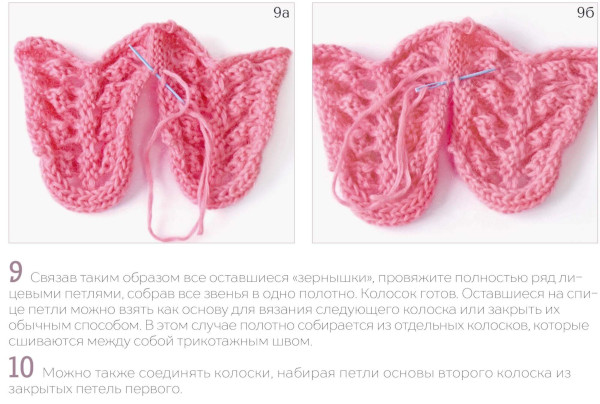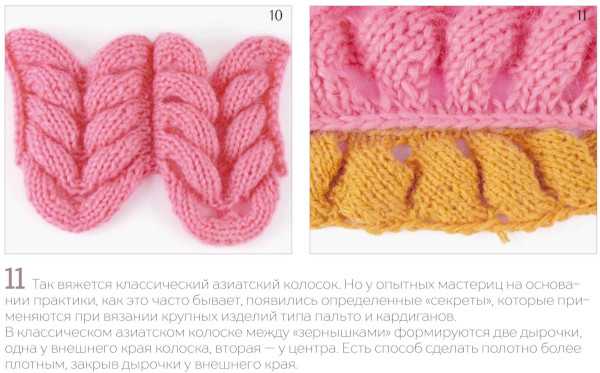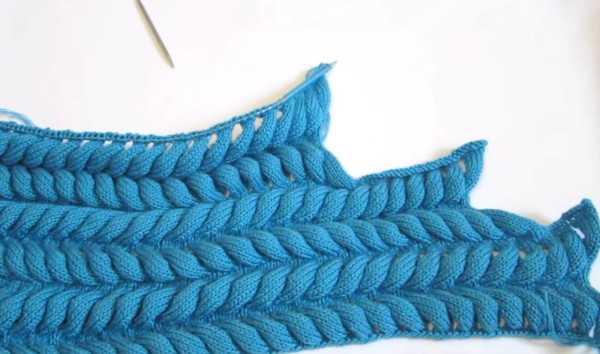When knitting a cardigan, sweater, hat, scarf often use an Asian spikelet, presented in the form of an unusual voluminous braid. Despite the fact that the pattern adds volume, it turns out to be elastic and soft, so it does not cause the product to become heavier. There are several schemes that allow you to use the ornament for the entire canvas or only for some parts.
Necessary tools and materials
Asian openwork spikelet is a unique knitting technique, thanks to which you can create a variety of beautiful and airy patterns using knitting needles.
Beginners are advised to use diagrams with detailed descriptions of the work to avoid mistakes in knitting. Additionally, you need to prepare high-quality thread material with tools.
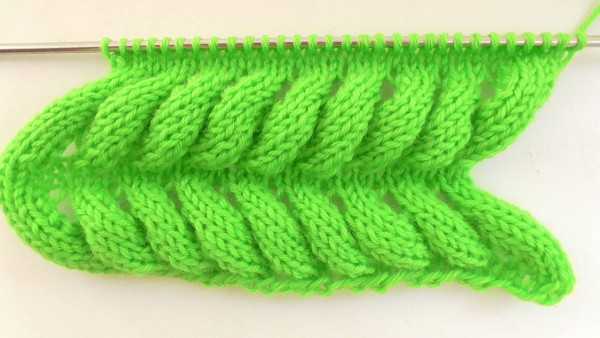
To create a pattern, it is acceptable to use light and thin material such as mohair or silk. This yarn helps to create a beautiful, airy and elastic ornament. When choosing a material, you need to pay attention to the composition of the threads.
It is optimal to use yarn with natural fibers so that the clothes are pleasant to the body and breathable.
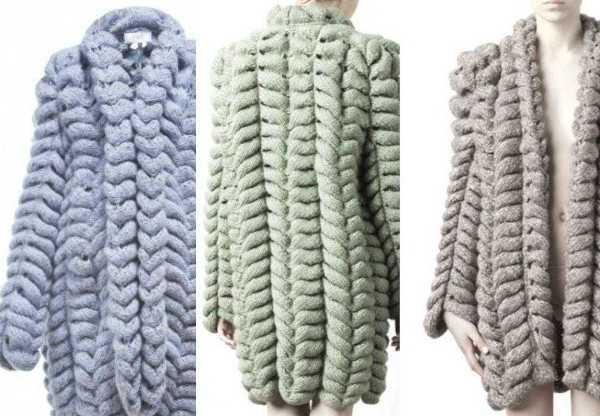
When knitting a cardigan, it is recommended to use circular knitting needles, the thickness of which varies between 5.5-6 mm. A mixture of acrylic and wool is suitable as a material.
When decorating a scarf, you can also use long circular tools. The material should be of medium thickness to obtain a clear openwork pattern.
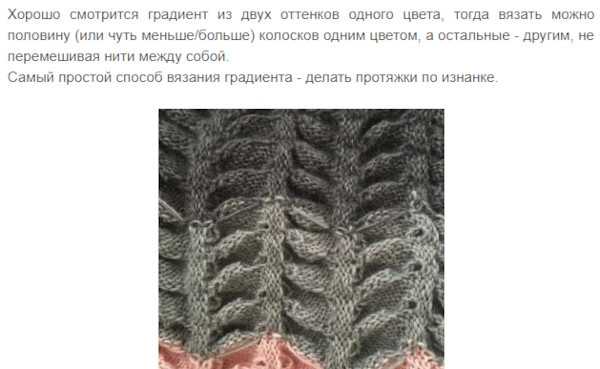
For example, you can use only natural wool or a blend of wool and acrylic to make the product easy to care for. Additionally, you need to pay attention to the shade of the threads so that the knitted item pleases you and matches the rest of your wardrobe.
To knit a hat, you can use knitting tool No. 2-2.5. It is best to use wool material with natural fibers so that the headdress is warm.
Schemes with description of works for beginners
Asian spikelet knitting (the diagram allows you to create a beautiful thing) is not vertical, but transverse knitting. In this regard, the set of the required number of stitches must be carried out not by the width, but by the height of the fabric. The spikelet is represented by 2 mirror-linked stripes, which are called grains. Thanks to these elements, the technique acquired such a name.
There are no clear restrictions regarding the size of the elements in the drawing. However, the appearance of the spikelet will depend on the proportions. In this regard, the master adheres to a certain ratio of the width and length of each link in the work.

For example, if the grain width is 4 stitches, then this element must be knitted on 10-12 rows, 6 stitches - on 12-14 rows, 8 stitches - 14-16 rows.
You can create an Asian spikelet using several patterns:
| Way | Features of knitting |
| 1 | The work requires knitting needles, which are used to create individual stripes. After these parts need to be sewn with a needle to create a single product. |
| 2 | Using stripes and knitting needles, you can immediately create a whole canvas. To do this, you need to adhere to the technique of turning rows. |
| 3 | To create the ornament you need a hook. First you need to make strips with holes, and then manually weave a braid from the strips. |
Filigree weaving is considered a popular type of openwork spikelet, because it delicately works out the details and helps to create a spectacular ornament that resembles a fillet pattern. Another type of pattern is a leaf spikelet, imitating the relief and shape of foliage. This type of pattern looks more natural.
For a cardigan
Asian spikelet knitting (the pattern requires step-by-step knitting of clothing parts) can be used to decorate a cardigan. In this case, the pattern will include 9 stripes, with the help of which it is necessary to knit a single product, without further sewing of elements. However, the sleeves must be knitted separately.
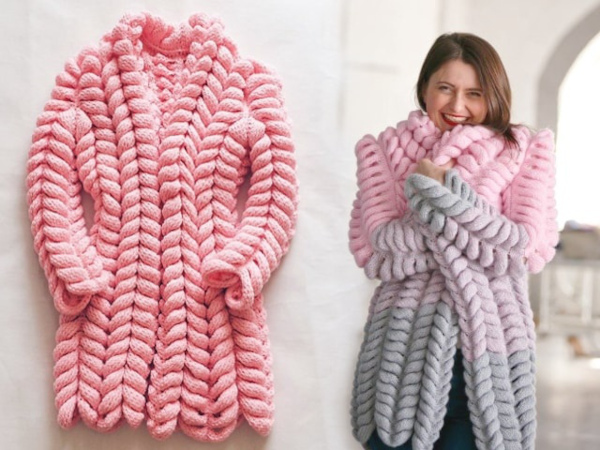
Technique for creating a collar:
- Cast on 132 stitches.
- 1 row consists of front elements.
- To create the 2nd row, first turn the product over and then knit the purl stitches.
- When knitting stripes further, there should be 8 front elements in 1 row.
- Turn the fabric over and make 8 purl stitches to create 2 rows. Turn the product over again.
- In the 3rd row there should be 8 knit stitches.
- After turning the work over, make 8 purl stitches to create the 4th row.
- Row 5 consists of 8 front elements.
- To make the first strip, continue knitting in the same way as rows 1-5, to a height of 14 rows.
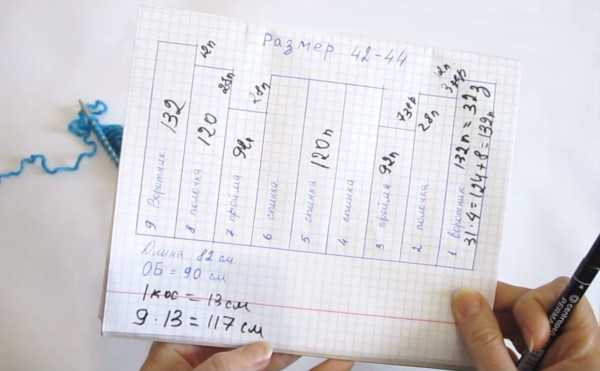
- To connect the new strip in 1 row make 8 front stitches and from the left tool 4 elements. Then unfold the fabric.
- In the 2nd row there should be 8 purl stitches and 4 unknitted stitches left on the knitting needle. Turn.
- Row 3 consists of 8 front elements. Make a turn.
- There should be 8 purl stitches in the 4th row and 8 knit stitches in the 5th row.
- These loops in the amount of 8 pieces are designed to a height of 14 rows.
- Connect the third strip in a mirror image. To do this, in the 1st row, knit 8 from the left tool, and 4 from the main product.
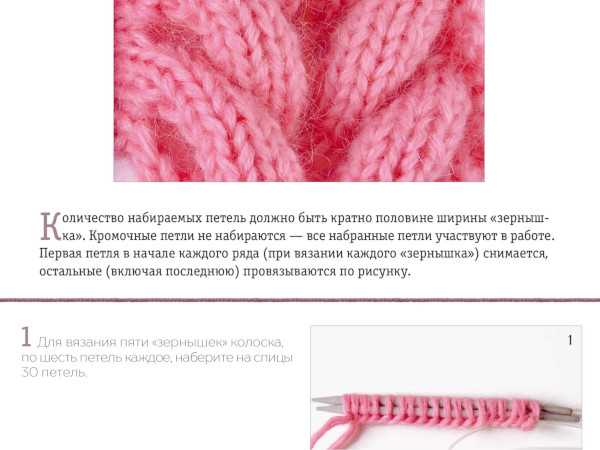
- In the 2nd row, make 8 purl stitches, and leave 4 elements on the left knitting needle and make a turn.
- Row 3 consists of 8 front stitches, and row 4 consists of 8 back stitches.
- Knit this number of loops to a height of 14 rows.
- To join the 4th grain, there should be 8 stitches in 1 row and 4 knit stitches from the main piece.
- In the 2nd row, make 8 purl elements, and leave 4 loops on the left tool.
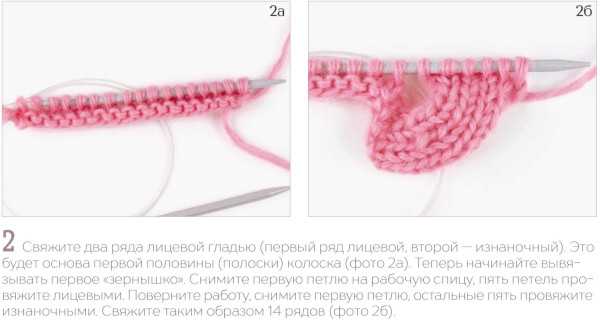
- Row 3 includes 8 knit stitches.
- To design the 4th grain, continue knitting to a height of 14 rows. Connect the remaining elements in the same way.
- When all the grains are done, make 1st and 3rd connecting rows of purl stitches. Rows 2 and 4 should consist of knit stitches.
- Turn the fabric inside out.
- 1 row consists of 8 purl stitches.
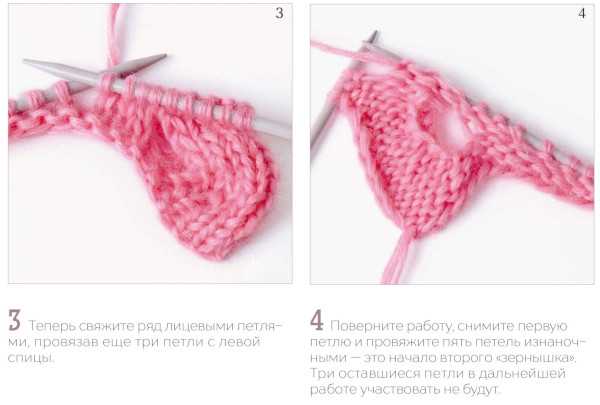
- After turning, make 2 rows of 8 front elements.
- Row 3 corresponds to row 1, row 4 corresponds to row 2. However, do not make turns in these rows.
- Make 14 lines in the same way.
- To join a new strip, in row 1, knit 8, and then 4 purl stitches from the main product.
- In the 2nd row, make 8 front loops, and leave 4 on the left tool.
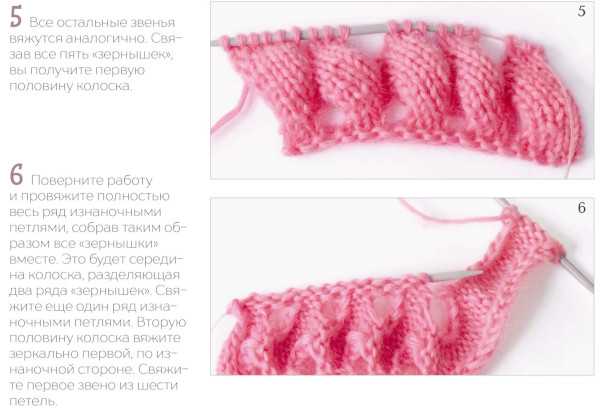
- The 3rd row consists of 8 purl elements, and the 4th row consists of 8 front elements.
- This strip should reach 14 lines.
- To join a new strip, row 1 consists of 8 and 4 purl stitches taken from the main piece.
- Rows 2 and 4 consist of 8 face elements.
- In the 3rd row make 8 purl stitches. Then turn.

- This strip should take up 14 lines.
- When finished, join all stitches together using the front elements.
- In a new row, knit 132 purl stitches. As a result, you will get a collar. Between the elements of the pattern, knit 4 rows with the front surface.
Technique for making a shelf:
- This garment piece should be 12 elements smaller than the collar, so at the beginning of a new row, close 12 stitches. To do this, close 2 elements together 6 times. Then continue knitting with face loops.
- The new row consists of only purl elements.
- To form a new spikelet, rows 1 and 3 include 8 front stitches.
- There should be 8 purl elements in the 2nd row.
- After lines 1 and 2, it is necessary to turn the canvas.
- The spikelet should take up 14 rows. The outer row should be purl.
- For a new connection, there should be 8 and 4 front stitches from the left tool in row 1.
- The 2nd row consists of 8 purl stitches, the 3rd row – of the same number of face stitches. However, after the 1st and 2nd rows, turn the fabric.
- The height of a new spikelet should be 14 rows.
Step-by-step description of knitting the armhole:
- This garment element should be 27 stitches shorter than the front, so close 28 elements at the beginning of the row, and then continue with the front elements. As a result, 92 loops should remain on the tools.
- The next row should contain only purl elements.
- To form a new spikelet, rows 1 and 3 consist of 8 front stitches, and row 2 consists of 8 back stitches. After rows 1 and 2, make a turn.
- The height of the spikelet consists of 14 rows, knitted in the same way as rows 1-3.
- To connect with the main work, initially knit 8 front and 4 front elements from the common fabric.
- In the 2nd row, make 8 purl stitches and also a turn.
- After the spikelet, make 2 rows of stockinette stitch.
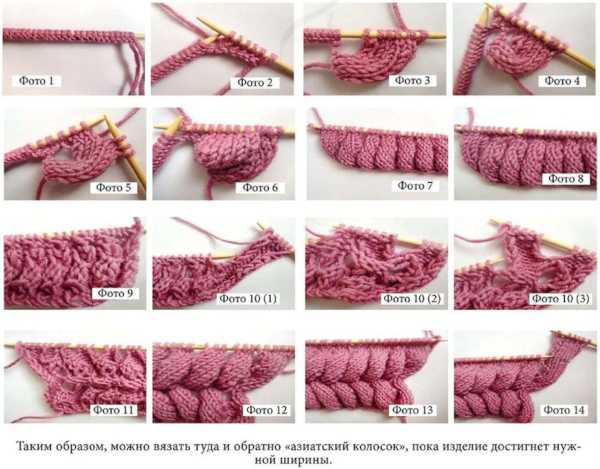
Step-by-step design of the back:
- The garment piece should be 28 stitches larger than the armhole, so make a set of 28 elements at the beginning of the row.
- In the next row, initially knit 28 stitches created. Then continue working with the front elements to finish the row.
- The new row should consist of purl stitches.
- Next, knit 2 additional rows using the front surface stitch.
- To create a new spikelet, make rows 1 and 3 with 8 front elements, and row 2 with purl elements in the same quantity. After rows 1 and 2, unfold the fabric.
- 8 front stitches, as in row 3, form to a height of 14 rows.
- To join with the general fabric, alternate 8 front and back elements in the next 4 rows. Additionally, in 1 row, knit 4 front stitches from the main product.
- After each row, except for row 1, make a turn. The height of the pattern element should reach 14 rows.
- The back should consist of 3 spikelets.
The sleeve should consist of 2 ears. For knitting, you need to prepare 6 mm thick knitting needles.
Step-by-step description of the work:
- For the first spikelet, make a set of 72 elements. Then in the 1st row, knit the front stitches, and in the 2nd row, purl stitches.
- To design the grain, there should be 8 knit stitches in rows 1 and 3, and 8 purl stitches in row 2. After rows 1 and 2, unfold the fabric.
- This element of the pattern should take up 16 rows. After that, make the next 2 rows with the front surface.
- For the second spikelet, knit 28 additional elements. As a result, there should be 100 stitches on the tools. The design of this spikelet corresponds to the first.
- On the front side, stitch the sleeve seam loop to loop on the side. Then move on to the shoulder seams. Sew the 2 halves of the collar and carefully attach to the neck.
- Fold the collar strip in half and sew it from the inside. Connect it to the armhole at the end of the sleeve.
For the hat
Asian spikelet knitting (the pattern is simple, so it is suitable for beginners) can be chosen for the design of the hat. The number of stitches of the set line should match the length of the main product. In this case, this number should be divisible by 6.

The edge elements are already included in this volume, so there is no need to collect them separately.
Step by step description:
- In 1 row make 6 front elements and unfold the fabric.
- There should be 6 purl stitches in the 2nd row.
- Similar to lines 1 and 2, arrange the given number of elements into 10 lines.
- In row 11, knit 9 front elements and turn the fabric over.
- Row 12 should have 6 purl stitches.
- After turning the product, continue knitting these 6 elements for another 10 rows. In doing so, take 3 stitches from the already created and new ones on the left knitting needle.
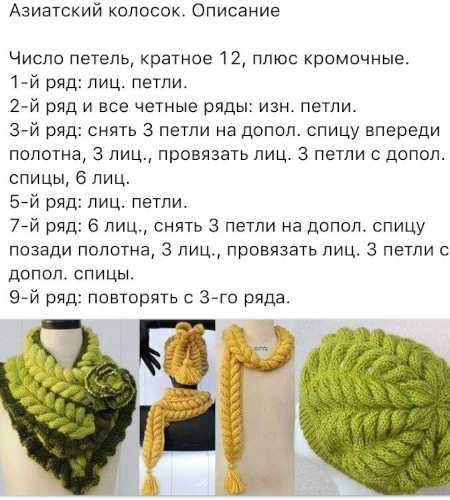
- Then make 2 new rows with purl or stockinette stitch. Repeat all steps, but work on the wrong side of the fabric using purl stitches to change direction.
- After that, make a ribbing to a certain height. Then make 2 rows with face elements and knit the ribbing again.
- The next 5 rows should consist of purl stitches. Then knit 3-4 Asian spikelets (as at the beginning of the description) and 5 rows of purl stitches.
- At the end of the work, the hat can be closed with any design.
For a scarf
Asian spikelet knitting (the diagram suggests making a voluminous product) is suitable for making an openwork scarf.
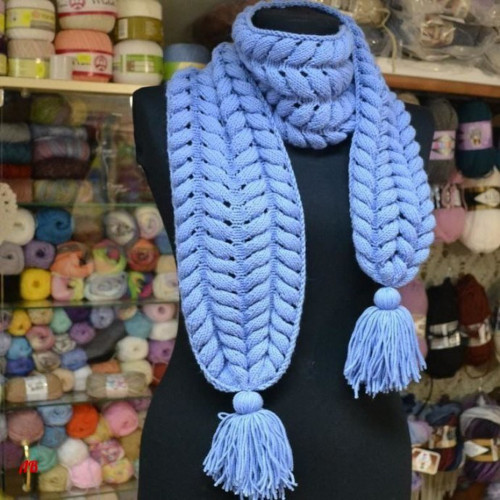
Step by step description:
- Make a set of 255 stitches. After 1 row, make with purl elements.
- In the 2nd row, make 10 front stitches and turn the fabric. Then knit the purl elements. In the same way, make 18 rows with the front surface.
- In row 19, make the ribbon stitches face stitches, continuing knitting along the fabric and creating 5 face elements.
- Turn the fabric over and make 10 purl stitches. 5 elements of the first tape should fall out of the knitting process and remain on the right tool.
- When turning the product over, make 10 front stitches to create 3 rows of the second ribbon. Knit 18 rows in the same way.
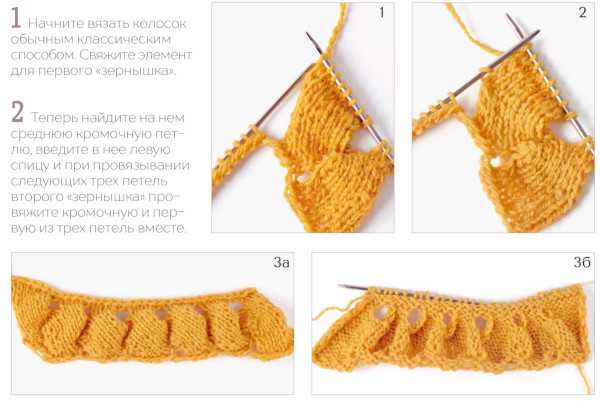
- In row 19, make the ribbon loops as front loops, and the next 5 stitches on the canvas. Then continue working in the same way as in step 4.
- When the last strip is done, make 4 new rows with the front surface, starting from the back. As a result, the tops of all the strips will be joined.
- Create the second part of the spikelet in the same way as the first.
- At the end, make 1 row with the front elements and the 2nd row with the back elements to connect the ribbons. If necessary, the item can be steamed.
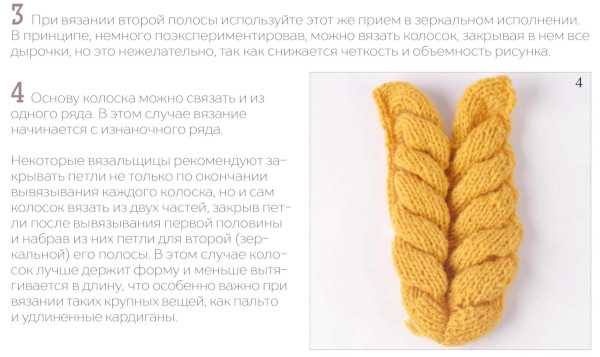
To obtain a wide fabric, you can additionally create 1 or 2 rapports in height. In this case, 4 rows must be made with the front surface, and the stripes must be made on the front part of the product. The stripes of the second part of the spikelet must be knitted on the back side.
Secrets for Beginners
Useful tips for knitting the pattern:
- Basically, there are 6 spikelet stitches per 10 rows. When choosing soft threads and creating a small fabric, this number of loops should be placed on 12 rows. For knitting a medium-sized fabric, 8 stitches should be on 12 or 14 rows, for a large size - on 16 rows. If the material is thin, it is advisable to make 10 stitches on 16 rows. But if the threads are very thin or light fluff is used, this number should be on 18 rows.
- To unravel the finished fabric to a small length, it is recommended to treat the thread material with talc.
- To hide the ends of the material, it is recommended to use a hook.
- To create a spectacular ornament, it is recommended to design the work using the ombre technique. Thanks to the smooth transitions, the tones will be evenly applied to the large relief knitting of this pattern.
- If cotton yarn was chosen for knitting, it should be taken into account that after the first wash the clothes will become 1 size smaller.
- If there are buttons on the clothes, it is recommended to treat the loops with a colorless varnish. This helps prevent the loops from stretching.
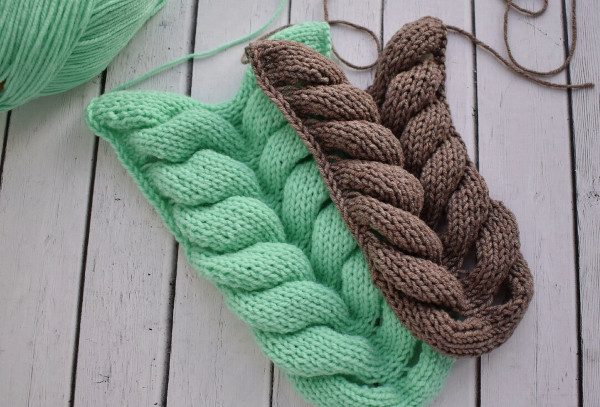
- Beginners are advised to knit a test sample and evaluate the result. This is required so that mistakes can be corrected or the knitting style can be changed before starting to make clothes. In this case, you need to choose simple patterns for creating an ornament to master basic techniques and gain experience.
- The knitted product cannot be steamed or ironed. To dry the item, you will need a dry towel on which you need to carefully lay out the clothes. This is because this pattern is elastic and soft, so it can stretch after washing. At the same time, the iron can catch on the holes in the ornament.
- The pattern is characterized by a three-dimensional appearance, so you will need 3 times more thread material than for knitting classic ornaments. When decorating a cardigan, you need to prepare at least 1.5-2 kg of material.
The knitting pattern of the Asian spikelet with knitting needles is mainly suitable for decorating warm clothes. As a result, you can get a spectacular, airy and unusual product.
Video about Asian spikelet knitting
Master class on knitting the hat "Asian spikelet" with knitting needles:

